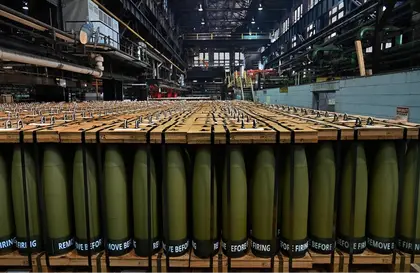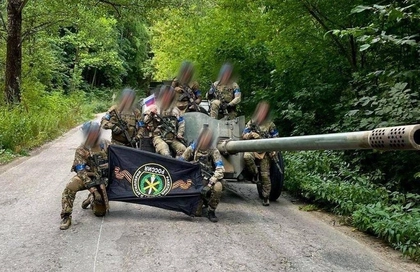An imaginative Czech plan to get Ukraine 800,000 critically needed artillery shells has found serious support and sufficient funding in Europe, but Kyiv’s hard-pressed gunners aren’t likely to get their hands on the ammo as fast as they need it.
“The Czechs have taken a very positive initiative to buy [artillery ammunition] outside of Europe. Countries are pledging money, also my country, providing funds for this. We have to move forward. Ukraine needs the weapons and the ammunition today,” said Latvian Foreign Minister Krišjānis Kariņš in Monday comments.
JOIN US ON TELEGRAM
Follow our coverage of the war on the @Kyivpost_official.
Prague officials in late February said they would take the lead in a pan-Europe initiative to find a half-million NATO-standard 155mm artillery shells, and 300,000 rounds fitting Soviet-standard 122mm cannon operated by the Ukrainian military, and then drum up cash to pay for it.
The emergency move came against a background of slower-than-expected gear-up of European shell manufacturing during 2023, and a three-months-long – so far – total halt to US arms and ammunition shipments to Kyiv.
Multiple European capitals have subscribed to the Czech plan to buy the ammo on international markets and ship it to Ukraine as soon as possible, and financing for all 800,000 shells has been promised, according to weekend news reports led by the Wall Street Journal (WSJ).
Prague’s initiative has found wide support across the continent, and Europe is deadly serious about getting artillery ammunition to Ukraine, Kariņš said.

Ukraine Targets Key Russian Rocket Fuel Plant with ATACMS and Storm Shadow Missiles
“This is now the third year that Ukrainians are fighting this war and they need weapons and ammunition. We tried in Europe, it was a little more than a year ago, we said that we would provide Ukraine with a million artillery shells being made in Europe. It turns out that we were not able to do this,” Kariņš said. “It’s clear that Russia will not change its course, so the question is what do we in Europe do, what is our response to this?”
Czech diplomats and arms traders have fanned out worldwide in a search for existing stocks of shells, particularly in countries major powers, such as the US or Germany, usually don’t do business with. Less than two weeks after President Petr Pavel said Czechia was going on an international shell hunt, vendors and stock had been found, the Prague-based Novinky.cz news platform reported.
Funding is reportedly in place as well, with countries including Germany ($500+ million), Belgium ($218 million), the Netherlands ($110+ million), Portugal ($110 million), Sweden ($33 million) and Slovenia ($1 million) having earmarked money to buy shells for Ukraine, news reports in those countries said.
Since publication of the Pavel plan, officials in Denmark, Greece, Canada, Lithuania, Belgium and Latvia have also declared they will help fund artillery shell purchases for Ukraine, but the value of those commitments hasn’t been reported.
Polish Foreign Minister Radosław Sikorski in a March 16 joint statement with his Czech counterpart said: “Urgent actions are needed… Buy artillery shells from sources and countries identified by the Czech initiative. Is not a time to be picky… Ukraine needs these shells immediately. On the battlefield it matters not where they came from.”
Major manufacturers of 155mm NATO-standard ammunition, outside the EU, include India, South Africa, South Korea, Japan, Turkey and Taiwan. The less-capable Soviet-standard 122mm shell is massively available worldwide, thanks to decades of Cold War exports by Moscow. The WSJ report said the Czech buyers were willing to consider sourcing from anywhere in the world, except North Korea.
The US, the world’s largest 155mm ammunition manufacturer by a significant margin, halted practically all military assistance shipments to Ukraine in December, because of lack of funding.
Petr Pavel on March 11 said the total cost of the artillery shell assistance package to Ukraine would be equivalent to $1.65 billion and that “if there are no fundamental problems, ammunition can reach Ukraine within a few weeks.”
Effectively land-locked because of an on-and-off Russian blockade of its seaports, Ukraine receives heavy-weight military assistance like artillery ammunition by either truck or rail. According to open sources, the most common route is through Poland via the NATO Ukraine logistical assistance hub Rzeszow, and less frequently via Romania.
Were Prague’s shell shoppers to locate excess 122mm in a European state known to have large stocks of the munition, like Bulgaria, Pavel’s “few weeks” prediction is logistically possible.
However, 155mm shell stocks inside Europe, according to NATO statements, need replenishing because they were badly depleted in 2023, mostly in transfers to Ukraine.
Ammunition sourced from outside Europe would need to sail to an EU port by sea, be transferred to rail or truck, and hauled across west and central Europe in order to reach Kyiv’s frontline troops.
A shipload of artillery shells from an Asian manufacturer – such as India, South Korea or Taiwan – would, exclusive of stevedore work and administrative delays, would typically be in transit for 30 to 40 days, before reaching a major European port like Rotterdam or Hamburg.
According to Ukrainian military analysts, an arms shipment arriving at a European seaport is usually at least two weeks in transit – and sometimes double that – before it physically reaches the Armed Forces of Ukraine (AFU). Actual transit times and routing of foreign arms deliveries are Ukrainian military secrets.
AFU official spokesmen first warned of probable future artillery ammunition shortages in October, citing limited domestic manufacturing, slow European ramp-up of shell production in 2023, and a looming fight in the US Congress over military aid to Ukraine.
Continuing Russian attacks exploiting falling Ukrainian firepower in 2024 scored a chain of victories in recent month, most notably with the Feb. 17 capture of the town Avdiivka, a fortified site held successfully by the AFU since 2014.
Russian pressure is currently greatest in the Kupyansk, Bakhmut and Robotyne sectors. Both sides have reported Russian advances and Ukrainian retreats in all three of those battle areas in recent weeks. Across the front, according to soldier accounts, Russian cannon outshoot Ukrainians by four shells to one.
Leadership of the US House has blocked legislation to send Ukraine more than $60 billion in military assistance from coming to a floor vote, for more than a month. The last delivery of US arms and ammunition to Ukraine for FY 2023 took place in December.
The bill, which also projects aid to Israel and Taiwan, would pay for close to one million artillery shells to be sent to Ukraine in FY2024, and would finance upgrades to US artillery production quadrupling manufacturing capacity.
Since January, with the US halt to arms assistance to Ukraine, Europe has increasingly taken the driver’s seat in international military assistance to Kyiv.
The EU in March announced plans to budget the equivalent of $545 to ramp up production of shells, explosives, powder, reconditioning of old munitions and testing. The upgrades will reduce bottlenecks, help member states refill stocks and deliver more ammunition to Ukraine on an “urgent” basis, an EU statement said.
You can also highlight the text and press Ctrl + Enter






